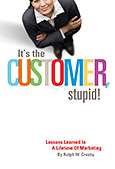Storytelling Impacts Consumer Behavior
In my newspaper reporter days, I often noticed how an emotional story would move people to action — to join a cause, to make a donation, or even make them cry. I realized that telling emotional stories could be related to the ancient maxim that people are motivated by both positive and negative emotions, such as love and kindness, fear and greed.
I brought that concept to marketing communications, developing storytelling campaigns that drive engagement between the client and the customer. While media buys, PR programs, etc. help get the message out, they won’t be effective if the message doesn’t connect.
Some recent evidence of that concept’s success comes from the American Red Cross and its “Storytellers Campaign.” This campaign features people who have been helped by the Red Cross record their experiences with the organization. “We captured their deeply personal stories and used them to form a multimedia program designed to educate and engage, and ask for volunteers, contributions, and blood donations,” explains Peggy Dyer, Chief Marketing Officer of the American Red Cross. The result, according to Ms. Dyer: “The initiative contributed to our most successful year-end fundraising effort ever and nearly doubled the previous year’s results.”
My agency produced a similar, successful campaign for the National Association of Social Workers (NASW). We developed a branding strategy and national public education campaign to change misperceptions of the social work profession and to broaden the understanding of who could benefit from the help of a social worker. To demonstrate how social workers help, we used a variety of real stories to link key audiences to the Association’s brand. These emotional “turnaround” stories, used in ads and on an NASW website we created, detailed how lives were changed through the help of a social worker. The campaign produced millions of website visits and many more millions of transit, outdoor and print ad views. (For more information on the NASW campaign, go to www.crosbymarketing.com.)
The value of emotional messaging has been backed up by behavioral research. Behavioral scientists have debunked the idea that decisions are made through logical, linear thinking. They discovered that emotions are critical in retaining and retrieving messages.
For example, the traditional thought about how people respond to advertising was “Think, Feel, Act.” But researchers found that when viewing an ad, consumers follow a different path to a purchase decision – “First FEEL, Then Think, Then Act.”
The American Association of Advertising Agencies came to a similar conclusion in a study on rational vs. emotional advertising appeals:
“Emotional appeals relate to consumers’ social or psychological needs. This messaging uses feelings, poignancy, humor, excitement and other engaging tactics to evoke emotional responses, thereby playing into people’s desire for love, belonging, security, self-esteem, status, etc., and connecting those positive feelings with the brand. (Note that ‘emotional’ is not synonymous with ‘creative’ ― puppies and heartwarming family scenes are not necessarily creative, and many creative ads aren’t particularly emotive.)”
Another study, by the United Kingdom’s Institute of Practitioners in Advertising, found that:
- Emotionally based campaigns outperformed rationally based campaigns on every single business measure in the cases studied ― sales, market share, profit, penetration, loyalty and price sensitivity.
- Emotional appeals are almost twice as likely to generate large profit gains as rational ones.
- The more emotion dominates over rational messaging, the bigger the impact on the business; the most effective ads are those with little or no rational content.
- Emotional campaigns create an enduring sense of differentiation for the brand.
- Even in categories that are supposedly rational, like computers and financial services, people go with their gut feelings first.
Marketers need to heed these studies and these campaign examples. They show that emotional storytelling is more important than ever to connect with consumers and impact their behavior.
###

 Businesses often are started by entrepreneurs with an idea, a product or service, or an expertise. Many of them fail, not because the idea or product isn’t good, but because their attention is overwhelmingly directed internally – e.g., what goes into the product – when they should focus externally, always reminding themselves:
Businesses often are started by entrepreneurs with an idea, a product or service, or an expertise. Many of them fail, not because the idea or product isn’t good, but because their attention is overwhelmingly directed internally – e.g., what goes into the product – when they should focus externally, always reminding themselves:
